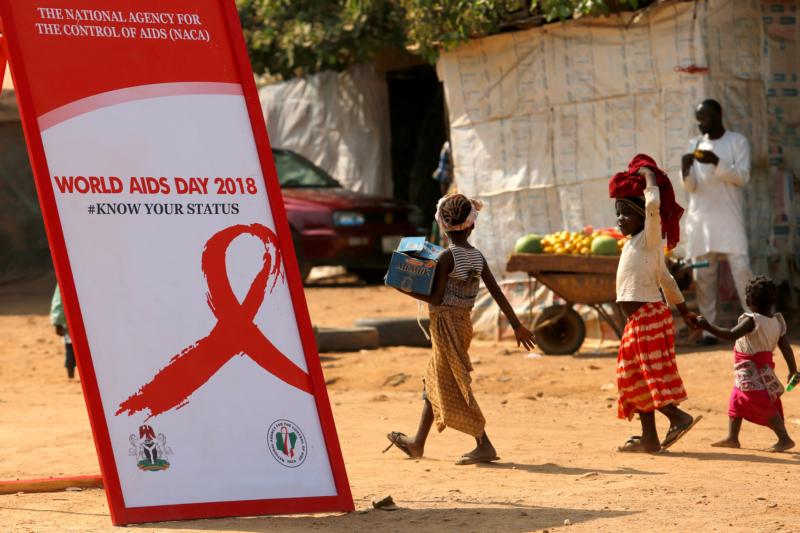
Children walk past a banner at a camp for internally displaced people in Abuja, Nigeria, during an HIV/AIDS awareness campaign Dec. 1, World AIDS Day. (CNS photo/Afolabi Sotunde, Reuters)
VATICAN CITY (CNS) — Responding to the deaths of tens of thousands of children from AIDS and AIDS-related illnesses, the Vatican brought together physicians and representatives of drug companies and humanitarian agencies to strategize ways to improve care for children and adolescents who are HIV-positive.
Cardinal Peter Turkson, prefect of the Dicastery for Promoting Integral Human Development, convened a “dialogue” at the Vatican Dec. 6-7 on the diagnosis and treatment of pediatric HIV.
The meeting aimed to “address bottlenecks that limit access to early infant diagnostic products and programs” as well as to “scale up strategies that can help quickly identify HIV-exposed children and link them to testing and treatment services,” according to Caritas Internationalis, which helped sponsor the event.
[hotblock]
While the global community has made great progress in improving access for adults to HIV and AIDS testing and treatment services, “more than 120,000 children continue to die each year from AIDS-related causes and over 13,000 children are newly infected each month,” said a Caritas press release Dec. 6.
The two-day dialogue was designed to develop a plan of action for introducing and expanding “optimized diagnostics and case-finding strategies for HIV” to reach those still lacking care and to “intensify commitments in key challenging areas,” such as in the development of treatments and in gaining regulatory approval of life-saving drugs and diagnostic tools, the statement said.
Cardinal Turkson invited to the consultations leaders of major diagnostic and pharmaceutical companies, governments, regulators, faith-based and other organizations who serve children living with HIV, and other “key stakeholders.”
The global community can save the lives of children still lacking adequate care “by providing early diagnosis and effective treatment to all HIV-infected children,” said Stefano Nobile, an advocacy officer for Caritas Internationalis’ focal point for health and HIV.
“Substantial gaps persist in diagnostic and treatment coverage for HIV-exposed children. In 2016, only 43 percent of HIV-exposed infants received an Early Infant Diagnosis (EID) test within the first two months of life,” Nobile told Catholic News Service Dec. 6 in an email response to questions.
[tower]
The dialogue’s purpose, he said, was not to point fingers and figure out who is to blame for the gaps in testing and treatment of so many children.
“The purpose of the dialogues is to not lose lives anymore, working together — despite different languages, different ‘core-businesses’ — but with an unique objective: make the life of children living with HIV better and save the life of those HIV-positive children not yet identified,” he said.
The meeting was a follow-up to three other consultations the Vatican and Caritas held with pharmaceutical companies in 2016 and 2017 and was designed to assess the progress that has been made and to intensify the commitment to expanding testing and treatment of children living with HIV.
The December meeting was organized with the AIDS Free Working Group of the Start Free, Stay Free and AIDS Free Framework, PEPFAR and UNAIDS, along with Caritas Internationalis and the World Council of Churches-Ecumenical Advocacy Alliance.
Caritas Internationalis works with communities to reach children, expand access to antiretroviral drugs as well as to increase education and awareness about the treatment needs of children with HIV, Nobile said.
“Caritas Internationalis is deeply involved in the ‘reaching more children’ side, in particular thanks to the GRAIL Project developed with Caritas Nigeria and Caritas Congo” within the framework of a UNAIDS-PEPFAR initiative, he said.
The unique strategy behind the GRAIL project — which stands for Galvanizing Religious Actors for better Identification and Linkage to Pediatric HIV — are the priests, religious leaders, nurses and doctors of faith-based health facilities who implement it, he said.
“After being trained on pastoral and scientific considerations in pediatric HIV pathology, they can deliver audience-appropriate HIV prevention and stigma reduction messaging to their communities,” he said.
PREVIOUS: Vatican urges adoption of global compacts on migration, refugees
NEXT: German prosecutors launch crackdown on church sex abuse



Share this story